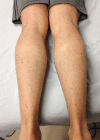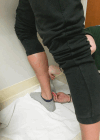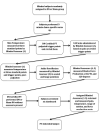Acute Effects of Dry Needling on Myofascial Trigger Points in the Triceps Surae of Ballet Dancers: A Pilot Randomized Controlled Trial
- PMID: 33842037
- PMCID: PMC8016472
- DOI: 10.26603/001c.21475
Acute Effects of Dry Needling on Myofascial Trigger Points in the Triceps Surae of Ballet Dancers: A Pilot Randomized Controlled Trial
Abstract
Background: There is convincing evidence that dancers suffer injuries to the triceps surae musculature. Research on the immediate effects of dry needling (DN) is limited, and it is important to understand the acute effects of this treatment prior to performance.
Purpose: The purpose of this pilot study was to assess the immediate effects of DN on myofascial trigger points in terms of skin surface temperature, pain, active and passive range of motion, and torque production in the triceps surae of ballet dancers.
Study design: Randomized, double-blinded pilot study.
Methods: Professional ballet dancers that fit inclusion and exclusion criteria (n=11) were randomly assigned to an experimental or control group. The dancers had three pre-determined standard point (SP) measurement spots that were used as a baseline for surface temperature comparisons. The dancers were also palpated for trigger point (TP) spots. Both SP and TP spots were marked for future measurements. The experimental group received DN, while the control group received sham DN (SHAM) to their bilateral calves at the TP spots. Immediately prior to and following treatment, both DN and SHAM groups were tested for skin surface temperature, pain, range of motion, and plantar flexion torque by blinded assessors. Paired t-tests and independent t-tests were performed to examine for differences between groups.
Results: The surface temperature for the TP was higher than the SP measurements prior to intervention (Right calf p= .014; Left calf p= .031). There were no significant changes in VAS scale reported pain and ROM. The plantar flexion torque measurements showed an increase in the DN group of the left calf at the angular velocity of 60 degrees/sec.
Conclusion: This was a unique pilot study examining the acute effects of DN on professional ballet dancers. The results were limited due to low sample size. However, the methodology for this study and surface temperature results invites future research.
Level of evidence: Level 1b.
Keywords: calves; dry needling; force; movement system; range of motion; temperature.
Conflict of interest statement
The authors report no conflicts of interest.
Figures
Similar articles
-
IMMEDIATE AND SHORT TERM EFFECT OF DRY NEEDLING ON TRICEPS SURAE RANGE OF MOTION AND FUNCTIONAL MOVEMENT: A RANDOMIZED TRIAL.Int J Sports Phys Ther. 2018 Apr;13(2):185-195. Int J Sports Phys Ther. 2018. PMID: 30090677 Free PMC article.
-
Changes in stiffness at active myofascial trigger points of the upper trapezius after dry needling in patients with chronic neck pain: a randomized controlled trial.Acupunct Med. 2023 Jun;41(3):121-129. doi: 10.1177/09645284221104831. Epub 2022 Jun 28. Acupunct Med. 2023. PMID: 35765779 Clinical Trial.
-
The Effects of 5 Minutes of Static Stretching on Joint Flexibility and Muscle Strength Are Comparable Between Ballet Dancers and Non-Dancers.J Dance Med Sci. 2024 Sep;28(3):168-178. doi: 10.1177/1089313X241241450. Epub 2024 Mar 26. J Dance Med Sci. 2024. PMID: 38529597
-
Effectiveness of Dry Needling of Myofascial Trigger Points in the Triceps Surae Muscles: Systematic Review.Healthcare (Basel). 2022 Sep 24;10(10):1862. doi: 10.3390/healthcare10101862. Healthcare (Basel). 2022. PMID: 36292308 Free PMC article. Review.
-
Efficacy of trigger point dry needling on pain and function of the hip joint: a systematic review of randomized clinical trials.Acupunct Med. 2024 Apr;42(2):63-75. doi: 10.1177/09645284231207870. Epub 2023 Dec 27. Acupunct Med. 2024. PMID: 38149616
Cited by
-
Immediate Effects of Instrument-Assisted Soft-Tissue Mobilization Versus Dry Needling on Trigger Point Pain and Tightness of Calf Muscles in Long-Distance Runners.Cureus. 2024 Apr 10;16(4):e57984. doi: 10.7759/cureus.57984. eCollection 2024 Apr. Cureus. 2024. PMID: 38738019 Free PMC article.
-
Dry Needling in Overhead Athletes with Myofascial Shoulder Pain: A Systematic Review.Sports (Basel). 2024 Jun 5;12(6):156. doi: 10.3390/sports12060156. Sports (Basel). 2024. PMID: 38921850 Free PMC article. Review.
-
Effect of Conservative Interventions for Musculoskeletal Disorders in Preprofessional and Professional Dancers: A Systematic Review.Int J Sports Phys Ther. 2023 Apr 1;18(2):328-337. doi: 10.26603/001c.73793. eCollection 2023. Int J Sports Phys Ther. 2023. PMID: 37020446 Free PMC article.
-
Dry Needling in Sports and Sport Recovery: A Systematic Review with an Evidence Gap Map.Sports Med. 2025 Apr;55(4):811-844. doi: 10.1007/s40279-025-02175-9. Epub 2025 Feb 10. Sports Med. 2025. PMID: 39928077 Free PMC article.
-
Effects of Trigger Point Dry Needling on Strength Measurements and Activation Levels of the Gluteus Medius: A Quasi-Experimental Randomized Control Study.Int J Sports Phys Ther. 2022 Dec 1;17(7):1404-1416. doi: 10.26603/001c.55536. eCollection 2022. Int J Sports Phys Ther. 2022. PMID: 36518833 Free PMC article.
References
-
- Intra-rater and inter-rater reliability of a weight-bearing lunge measure of ankle dorsiflexion. Bennell Kim, Talbot Richard, Wajswelner Henry, Techovanich Wassana, Kelly David. 1998Australian Journal of Physiotherapy. 44(3):175–180. doi: 10.1016/s0004-9514(14)60377-9. doi: 10.1016/s0004-9514(14)60377-9. - DOI - DOI - PubMed
-
- Biomechanics of the foot in dance: A literature review. Ahonen J. 2008J Dance Med Sci. 12(3):99–108. - PubMed
-
- Functional characteristics of the plantar flexors in ballet dancers, folk dancers, and non-dancer populations. Thomas K.S., Parcell A.C. 2004J Dance Med Sci. 8(3):73–77.
LinkOut - more resources
Full Text Sources
Other Literature Sources
Research Materials




